Winter in Olympic National Park: 7 Things to Do + What’s Open

Wondering if it’s worth braving the cold to explore Olympic National Park in winter?
As a local who visits year-round, I can confidently say—absolutely.
Winter brings a stillness and solitude you won’t find any other time of year.
Yes, some places like Sol Duc Hot Springs close for the season, and you’ll need to pack rain gear and warm layers. But the lack of crowds more than makes up for the extra preparation.
➥ If it’s your first time visiting Olympic National Park in December, January, or February, here are the best things to do—from snow-covered mountains and moody rainforests to stormy beaches and bonus adventures just outside the park.
You’ll learn which roads and areas remain open, what to pack to stay safe, and where to stay.
Bundle up and let’s go!
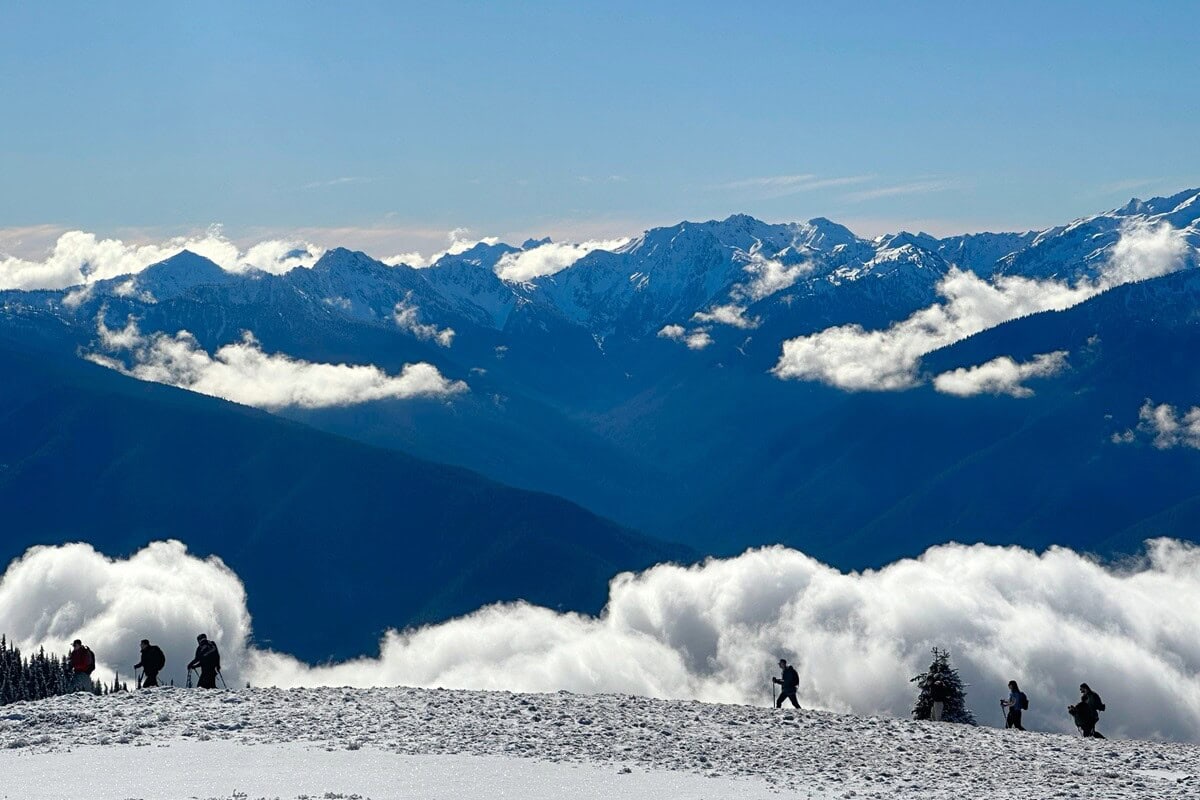
Winter in Olympic National Park: Access & Quick Tips
Conditions can change fast, so always check park alerts before your trip.
Despite this reminder (which I make in almost every post), what did I do one January?
I made the rookie mistake of checking road conditions on the way up Hurricane Ridge Road instead of before we left. Turns out the road was closed for the day.
Luckily, there’s always a Plan B—just know your options ahead of time.
Here’s what’s typically open in winter in Olympic.
Need help?
Planning a trip to Olympic in winter can be tricky—closures, weather, and limited daylight all add complexity. I offer custom itinerary planning services to help you save hours (or days!) of research.
Port Angeles Visitor Center
- Open daily year-round with restrooms, water station, maps, exhibits
- Rangers available for questions and up-to-date conditions
Port Angeles is the best city near Olympic National Park for last-minute supplies and snowshoe rentals, and where many first-time visitors begin their national park adventure.
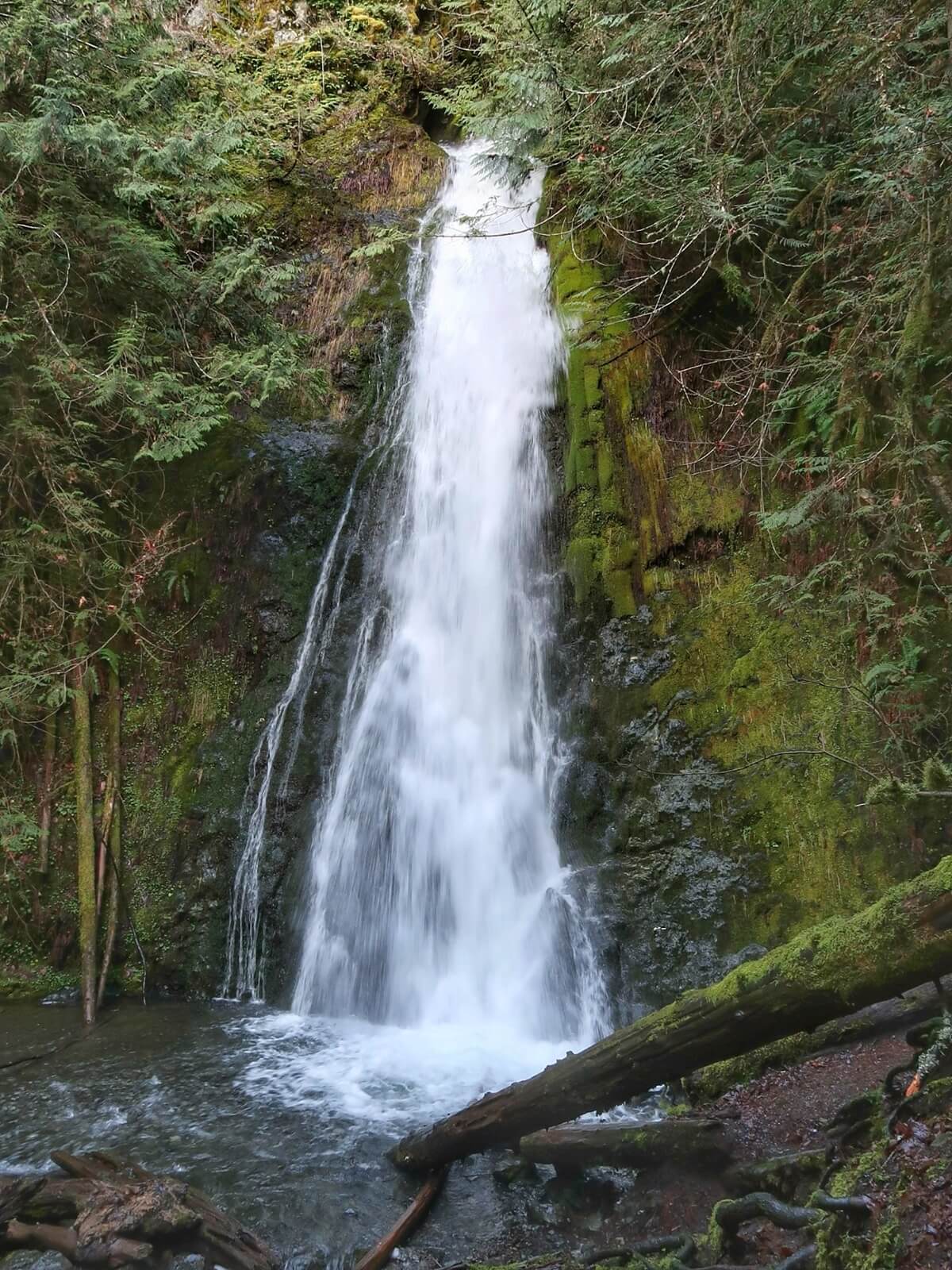
Madison Falls & the Elwha River
- Open year-round
- Access via Olympic Hot Springs Road (closed beyond the trailhead)
Hurricane Ridge
- Open Friday–Sunday in winter, weather permitting
- Chains required for all vehicles
- Cross country skiing and snow sports
Lake Crescent
- Open year-round
- Lake Crescent Lodge has reduced operating hours after New Year’s
Sol Duc Valley
- Open year-round
- Hike to Sol Duc Falls possible—but check for road closures
- Resort closed in winter
Pacific Coastline (Shi Shi, Rialto, Ruby, La Push & Kalaloch beaches)
- Open year-round
- Kalaloch Lodge stays open in winter
Hoh Rainforest
- Open unless erosion closes road
- Visitor center closes January through early March
Quinault Rainforest
- Open year-round
- Lake Quinault Lodge stays open in winter
7 Best Things to Do in Olympic National Park in Winter
From snowy mountain adventures to peaceful rainforest walks, these are the winter activities I recommend most—especially if you’re planning your first visit.
1. Hike or Snowshoe at Hurricane Ridge
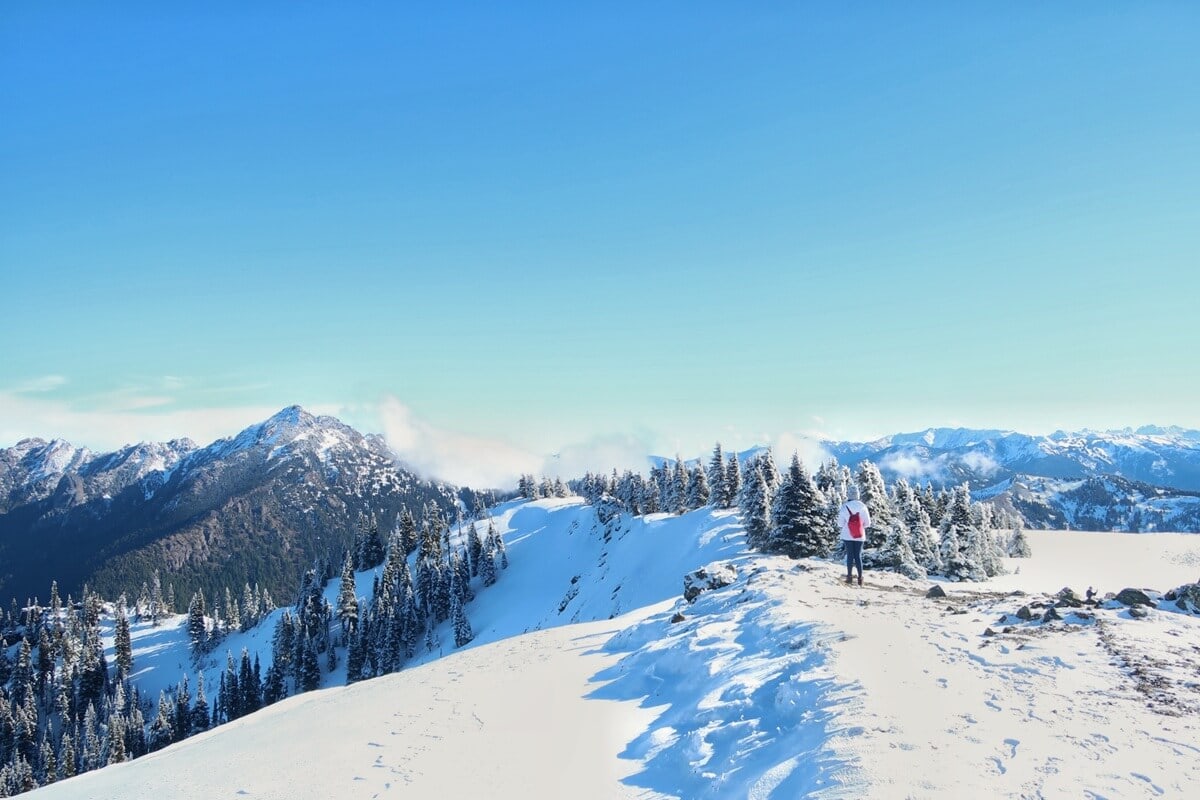
On clear days, few places in the park are more spectacular than Hurricane Ridge in winter.
During a late January snowshoe trip to Hurricane Hill, I loved watching clouds drift slowly through the valley below the snow-covered Olympic Mountains. At the top, we were treated to a clear view of Mount Baker in the distance and even Vancouver Island across the Strait of Juan de Fuca.
If snow levels are low or trails are packed, microspikes may be all you need instead of snowshoes.
Just remember: access is weekend-only, and the road may close unexpectedly, so always check alerts before you go. Carry tire chains and check Mountain Forecast for weather conditions.
Check out the ski and snowboard area here.
2. Hike to Frozen Lake Angeles
- Trailhead: Google maps
- Distance: 7 miles
- Elevation: 2,480 feet
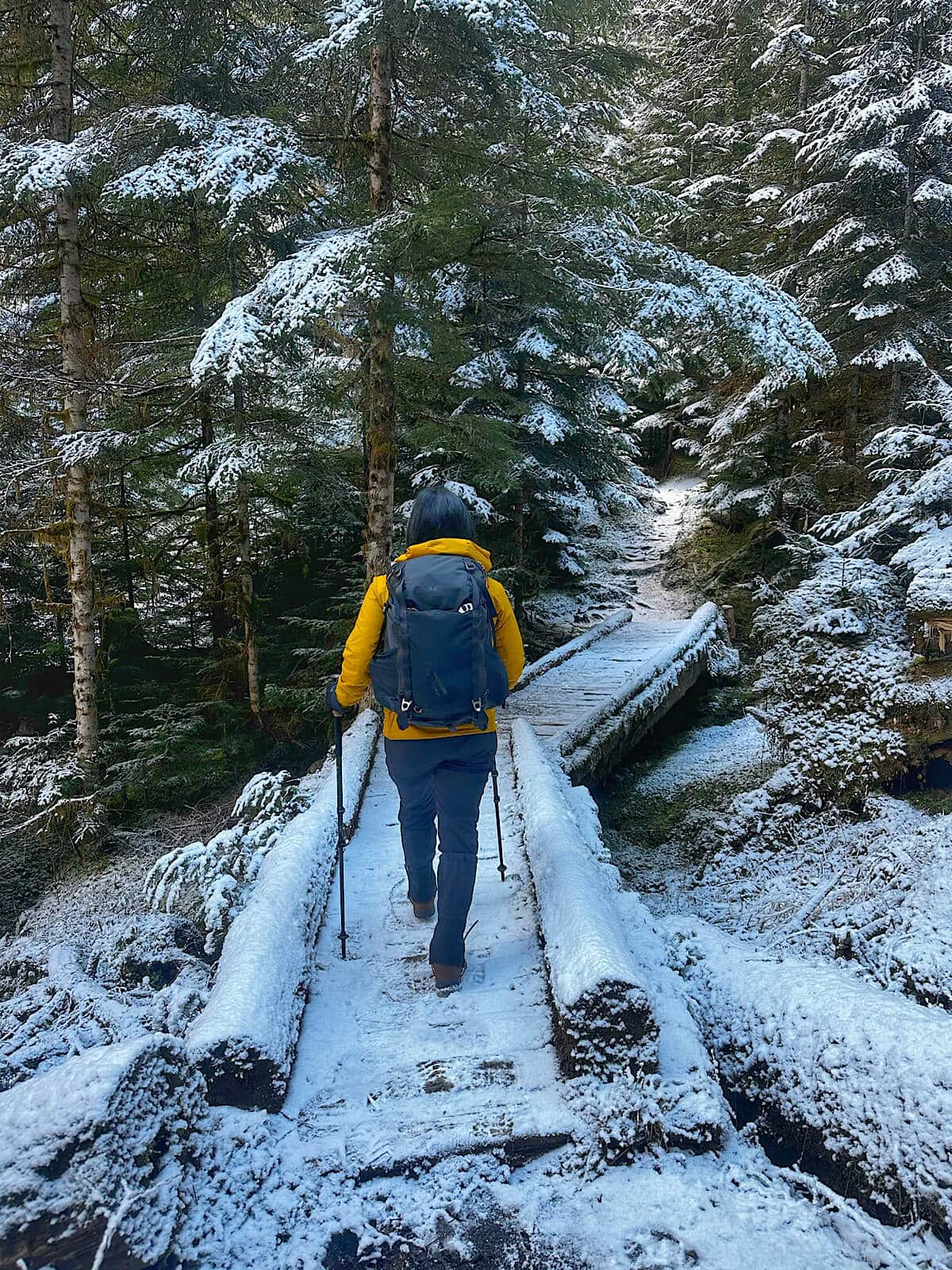
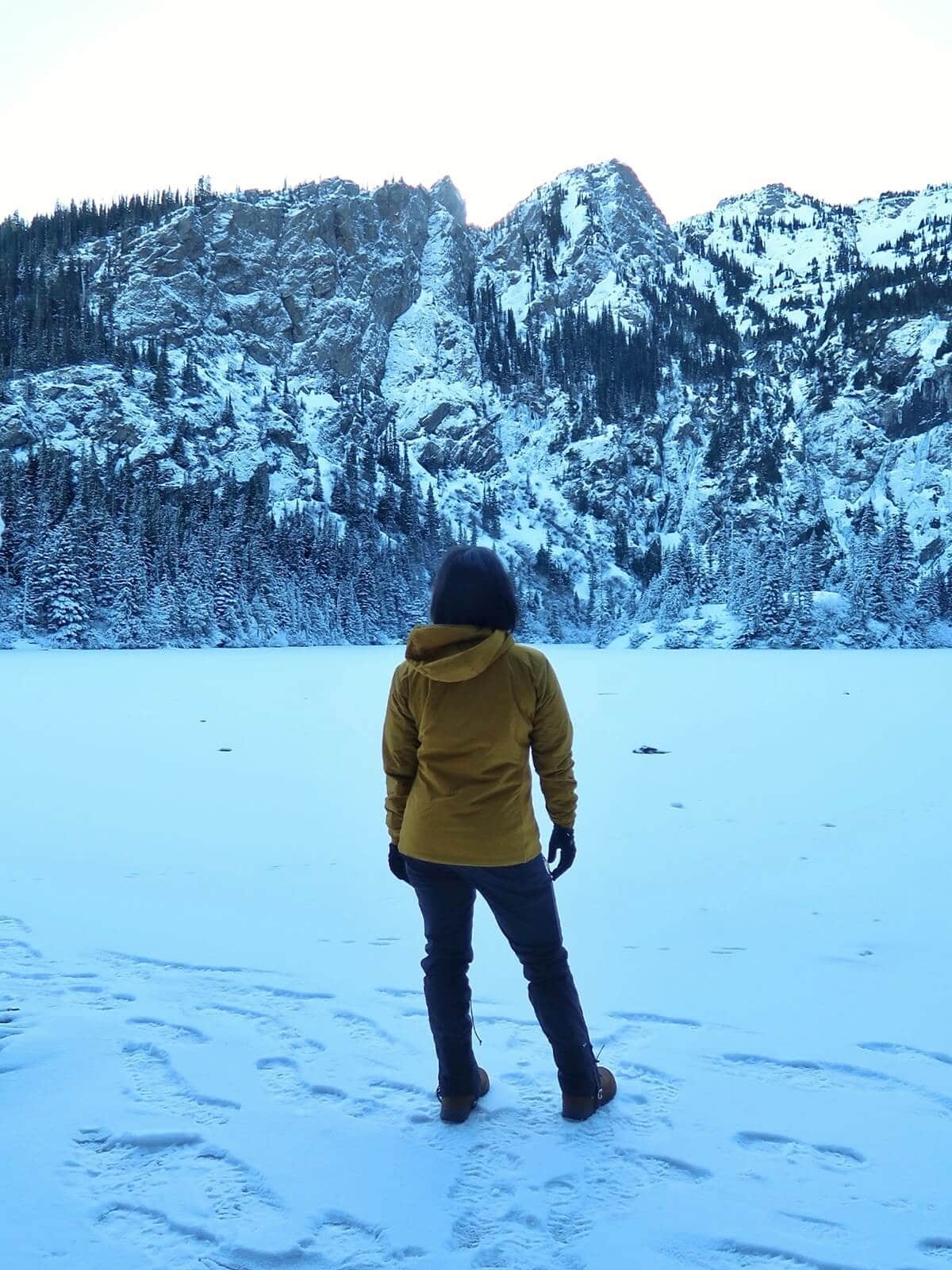
One of my favorite winter hikes in Olympic National Park is Lake Angeles—especially when the lake is frozen and the surrounding basin is blanketed in snow.
Despite this trail being our Plan B the day the road to Hurricane Ridge was closed, the landscape was unforgettable. Jagged gray rock faces were dusted in snow, icicles hung from the cliffs, and a small island of trees in the center of the lake looked positively magical (though definitely not safe to walk to).
Another fail for the day was that my hydration bladder’s hose froze while we ate at the lake. Thankfully, my hiking partner had an extra Nalgene she let me borrow.
TIP: Plan for snow, ice, and dropping temperatures higher up. I wore my insulated winter boots and gaiters, and kept microspikes in my pack.
3. Take a Quiet Walk on Lake Crescent’s Shoreline
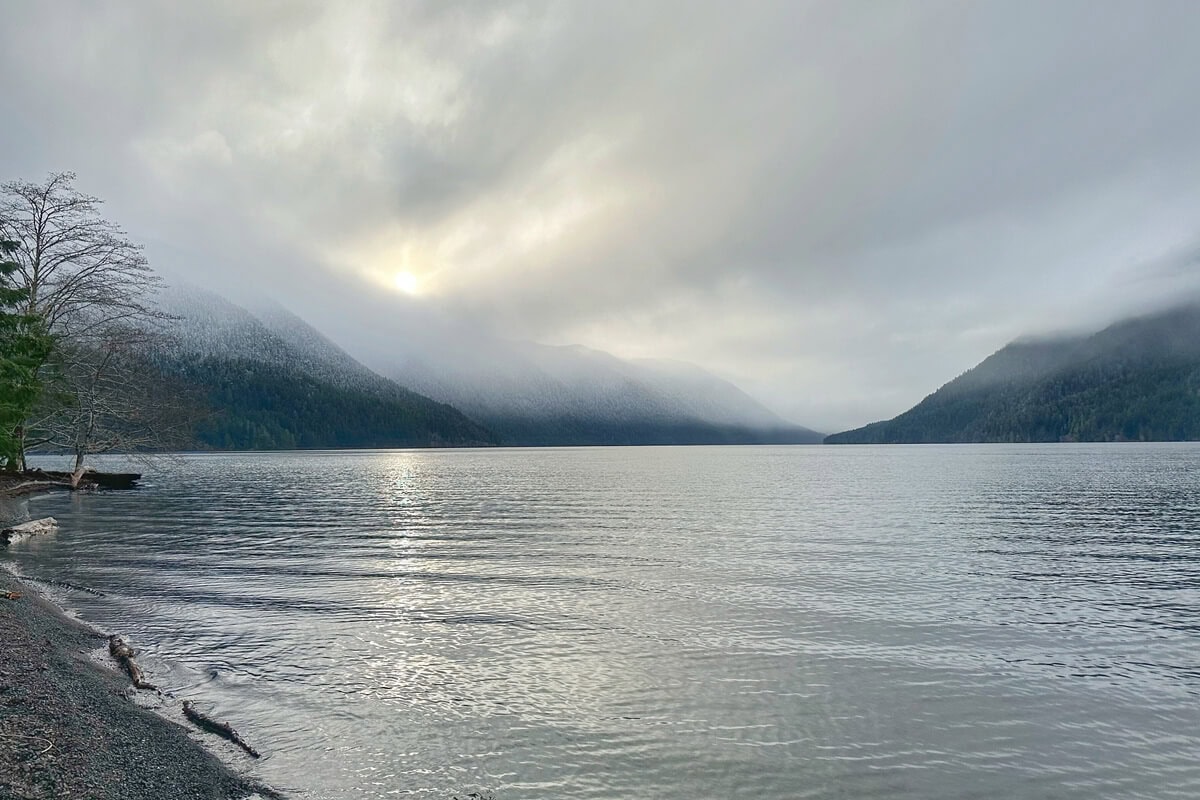
When roads to higher elevations are closed, Lake Crescent is one of the best places to savor the stillness of Olympic in winter.
I had the Moments in Time Trail all to myself on one late winter visit. Fallen leaves covered the ground, moss glowed vividly on tree trunks, and the landscape felt wild and untouched. As I walked to the shoreline, mist drifted across the lake and clung to the nearby ridges.
While you won’t get the aquamarine hues the lake is known for in summer, the area is easily accessible and never crowded.
Other easy Lake Crescent hikes include Marymere Falls and the Spruce Railroad Trail. You can also hike Mount Storm King for a more challenging adventure.
4. Watch a Storm Roll In from First Beach
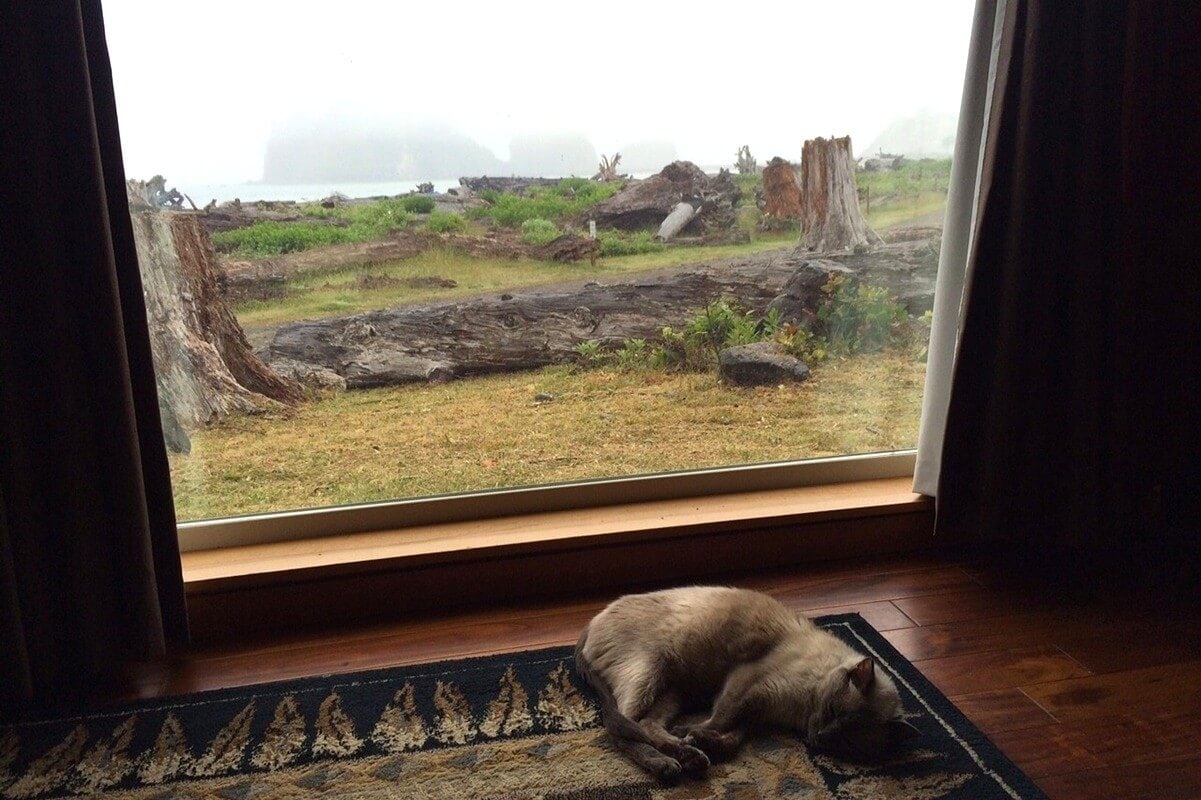
First Beach in La Push is one of the most accessible and awe-inspiring places to experience the raw power of the Pacific in the winter season.
The coziest—and safest—way to watch a coastal storm is from a cabin at Quileute Oceanside Resort. We’ve stayed in their deluxe cabins, which feature floor-to-ceiling windows with ocean views, so you can watch the drama unfold without getting soaked.
If you head to any of Olympic National Park’s beaches, keep a very safe distance from the water. Never climb on driftwood to avoid the waves—logs can easily shift or roll with the surf.
5. Wander Through the Hoh Rainforest in Winter
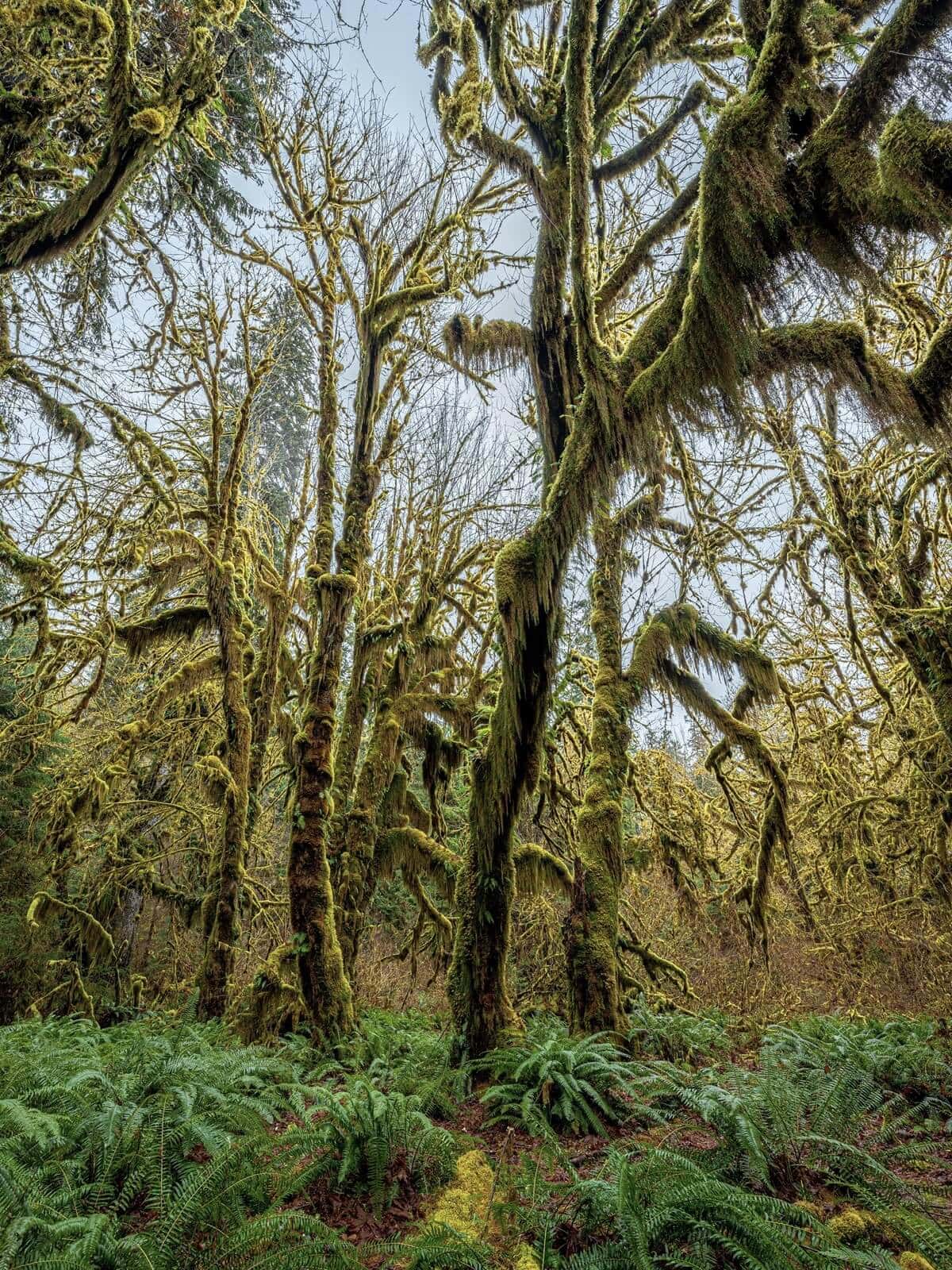
The Hoh Rainforest looks completely different in winter—moss hangs heavy and covers almost every surface, absolutely drenched.
Water drips from the canopy, and the filtered winter light gives everything a moodier vibe. Walking the Hall of Mosses Trail in the off-season, the contrast between bare maples and vibrant swordferns is especially striking.
Expect muddy sections, slick roots, and occasional trail debris after storms. Waterproof hiking shoes or boots are a must, and trekking poles help with balance.
While it’s still a popular spot year-round, you’ll avoid the long entrance lines and summer crowds.
6. Warm Up at Kalaloch Lodge or Lake Quinault Lodge
After a day of cold, wet hiking or coastal storm watching, few things feel better than a warm place to land. Fortunately, you can choose from two classic national park lodge experiences, even in winter.
Lake Quinault Lodge—my personal favorite place to stay on the peninsula—offers a secluded rainforest setting and nearby hiking trails.
Tucked into the park’s southern region, it’s the perfect getaway. After a full day of hiking, we sat down to a delicious dinner in the Roosevelt Dining Room and ended the night warming up by the lobby’s grand fireplace.
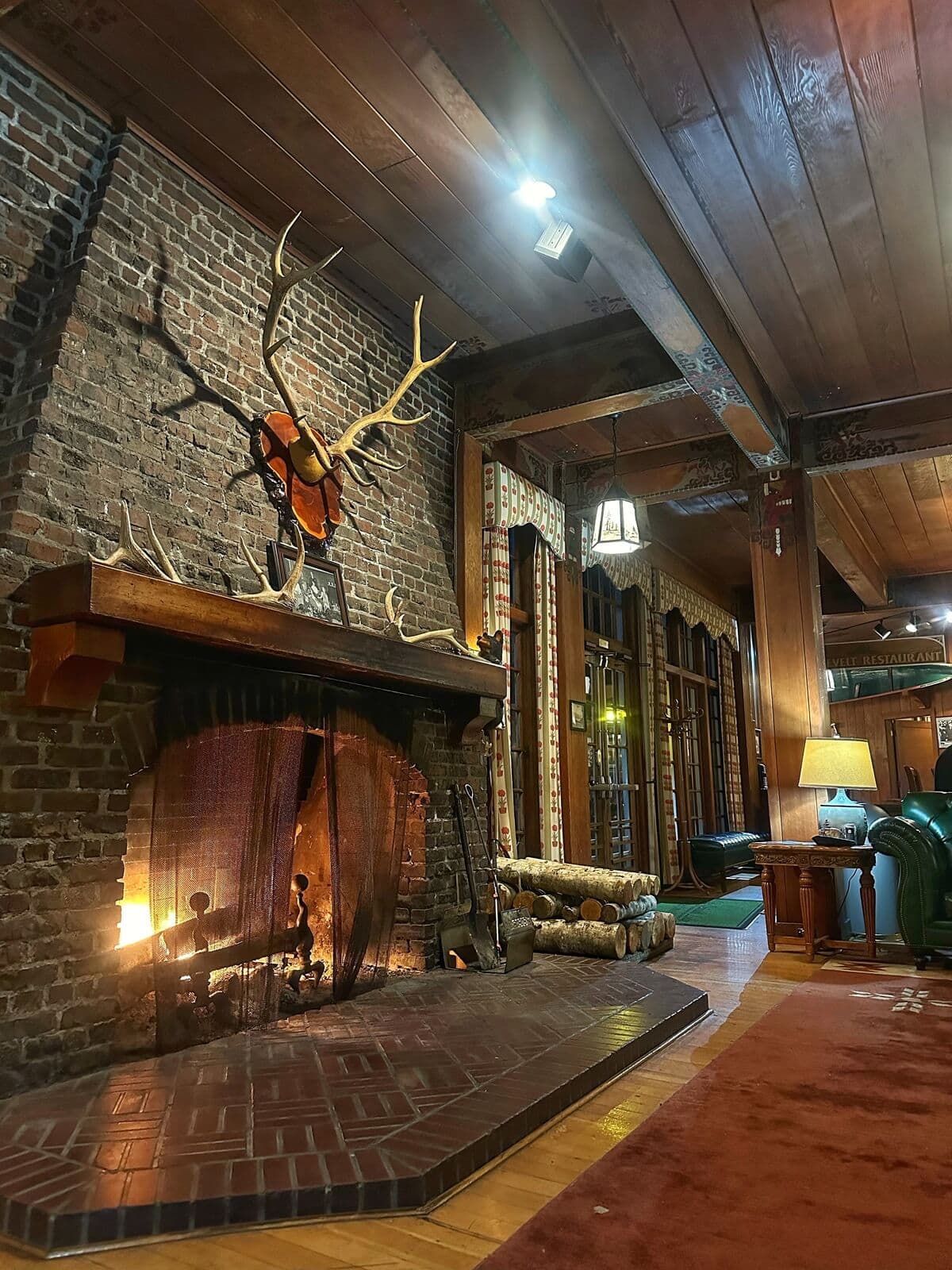
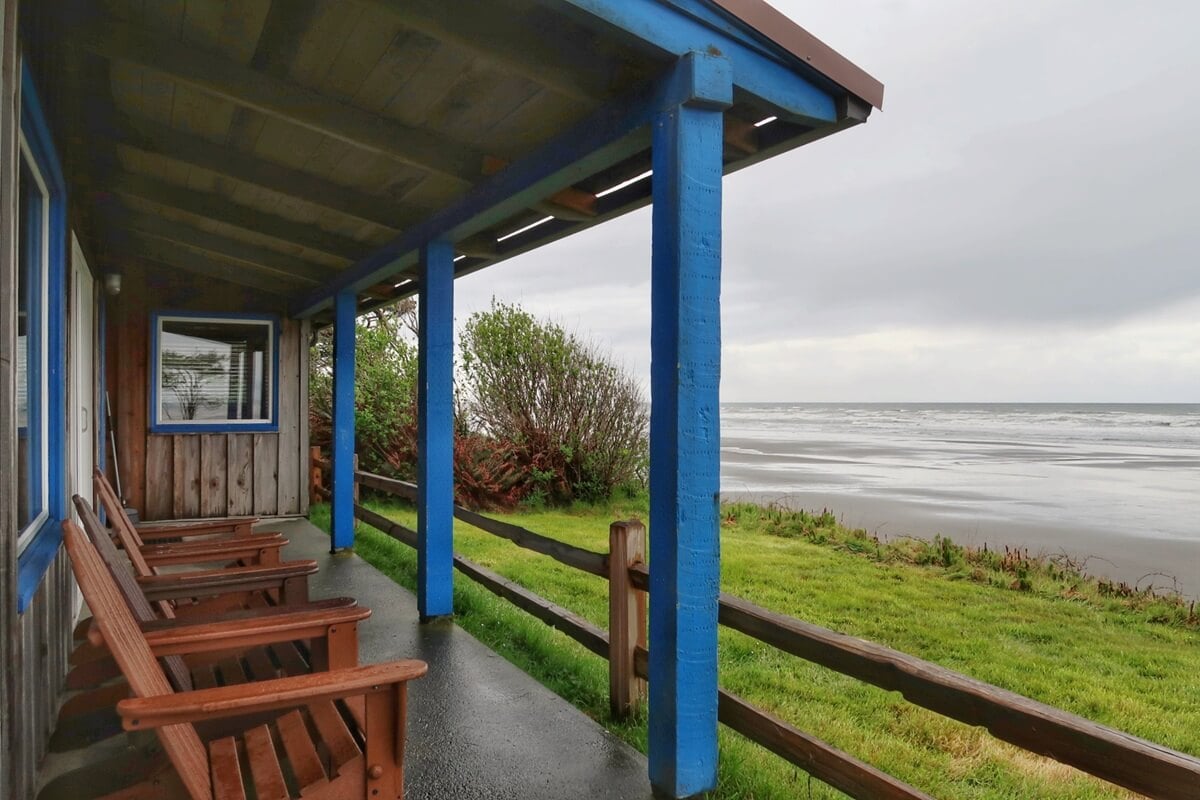
Kalaloch Lodge, perched above the Pacific, is open year-round.
Watch storms roll in from the comfort of your room, eat hot meals at the Creekside Restaurant, and walk down to the beach between showers. We stayed in the deluxe Kalaloch Suite in the main lodge and were blown away by the panoramic ocean views.
TIP: Book early for weekends or holidays—these lodges are popular even in the off-season.
7. Discover Waterfalls & Creeks in the Quinault Rainforest

Winter in the Quinault Rainforest is magical: streams are full, waterfalls are roaring, and everything feels alive.
On one sunny January day, I hiked the Kestner Homestead Trail before finishing on the connecting Maple Glade Nature Trail. Moss-draped bigleaf maples arched over a reflective stream. Sunlight filtered through the canopy, lighting up the already glowing moss.
Later that afternoon, I stopped at Merriman Falls, a 40-foot stunner tucked into the roadside rainforest. You don’t need to hike to see it—just pull off the South Shore Road and enjoy close-up views of the water cascading down moss-covered logs and rocks.
Bonus – Best Day Trips on the Olympic Peninsula in Winter
Looking to extend your trip beyond the park boundaries? These scenic Olympic Peninsula stops are well worth the detour.
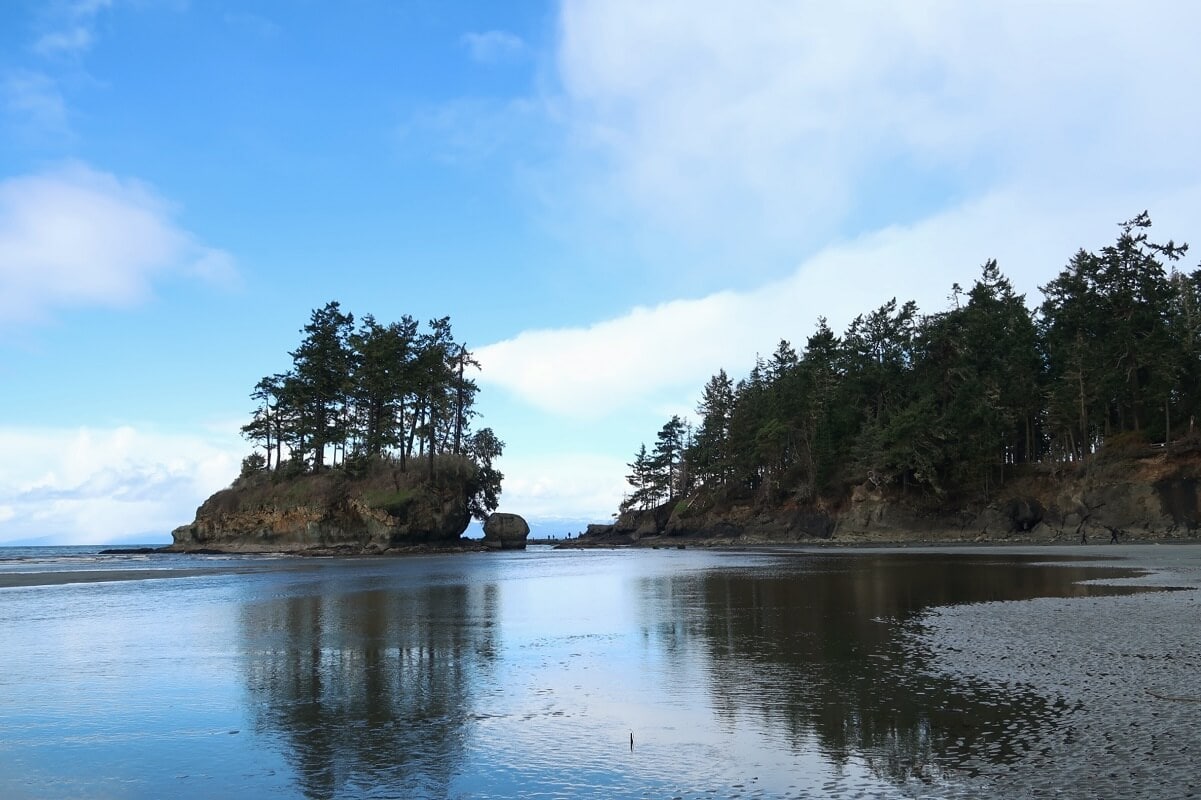
Explore Sea Stacks & Tidepools at Salt Creek
Just twenty minutes from downtown Port Angeles, Salt Creek Recreation Area rivals the wild and rugged beauty of Olympic’s Pacific Coast beaches. Stroll Crescent Bay’s sandy shoreline and explore tide pools at Tongue Point at low tide.
Visit Cape Flattery for Coastal Cliff Views
The journey to Cape Flattery, the northwesternmost point in the contiguous US, begins with a scenic coastal drive along Highway 112. Your reward is seeing stunning coastal cliffs, sea stacks, and crashing waves. Misty winter light makes it especially photogenic.
Walk the Holiday-Lit Streets of Downtown Port Townsend
In December, this coastal city’s historic downtown glows with festive lights. Port Townsend attractions include Victorian architecture on Water Street, local shops like Vespertine Boutique, and harbor views from Tyler Street Plaza.
➜ Want help from a local planning your Olympic Peninsula winter itinerary? Book a call and together we’ll plan a custom trip that’s flexible enough to overcome unexpected closures.
Winter in Olympic Packing List
I’m 90% on board with the saying “There’s no bad weather, only bad clothing.” I reserve 10% for the occasions when our region gets inches of rain in a single day.
Waterproof gear is an absolute must, along with other key items to pack for a trip to Olympic listed below:
Weather Protection
- Rain jacket
- Rain pants
- Insulated “puffy” jacket
- Waterproof shoes or boots
- Gaiters
Top your layers with an insulated jacket to stay warm. Look for one that’s fitted enough to slip under a rain shell. Layering gives you more flexibility than a bulky parka—so you can adjust as the weather shifts throughout the day.
Traction & Safety
- Microspikes or snowshoes (depending on conditions)
- Headlamp with extra batteries
- Emergency shelter (lightweight bivy or blanket)
Clothing Essentials
- Breathable base layers
- Extra socks
Other Winter Must-Haves
- Extra food and high-calorie snacks
- Dry bag for electronics and essentials
- Extra water in Nalgenes
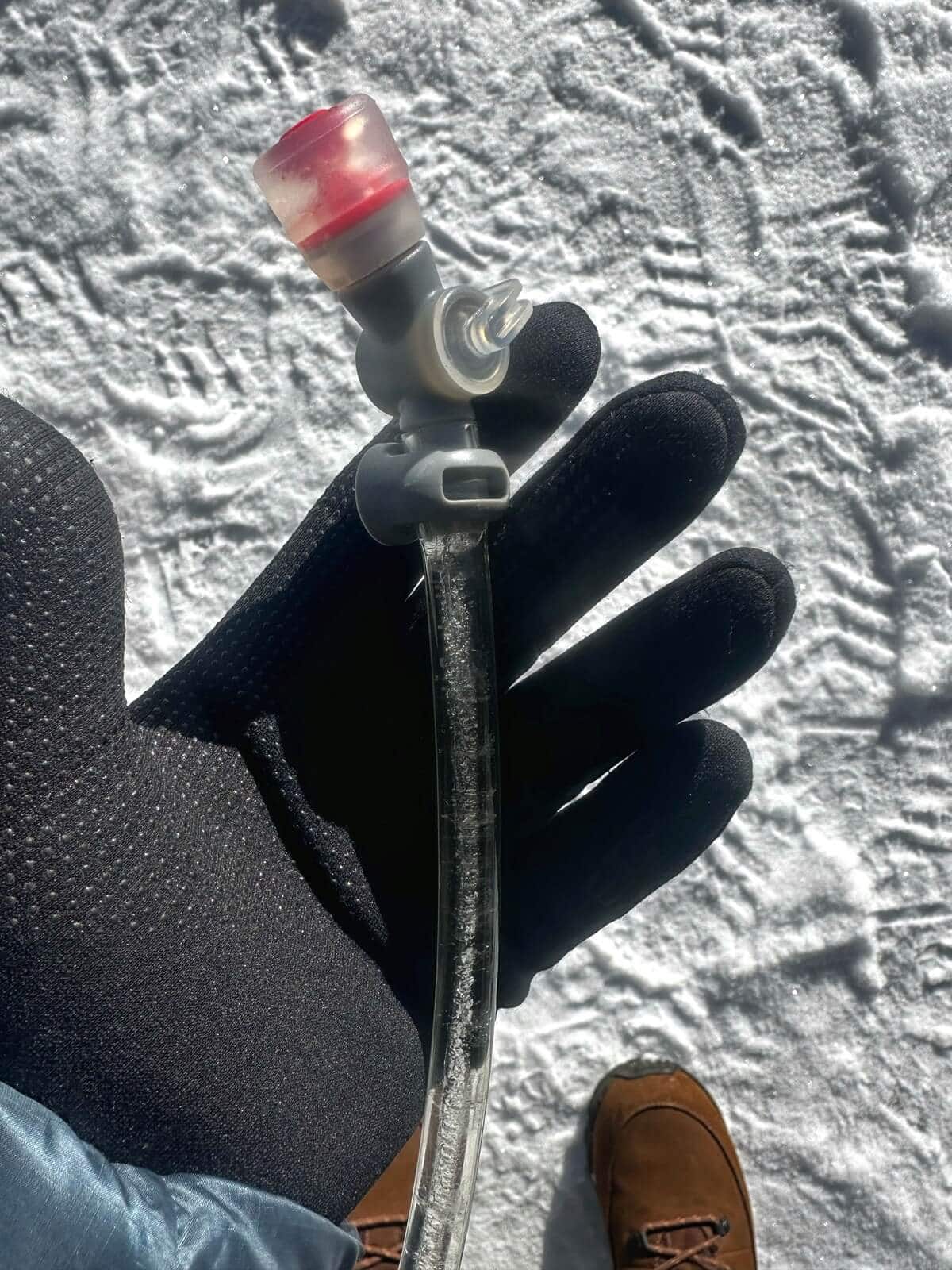
Where to Stay in Olympic National Park in Winter
My top recommendation I make to clients on a trip planning call is to split their stays by region, usually Port Angeles and Forks.
This helps reduce driving time, which is especially important in winter when days are naturally shorter.
Port Angeles
Stay in Port Angeles for access to Hurricane Ridge and Lake Crescent.
- Best Hotel: Olympic Lodge offers the most amenities of all Port Angeles hotels, including a heated outdoor pool.
- Best Budget Pick: Super 8 by Wyndham has clean rooms and excellent service. When I forgot our snowshoes, the front desk rep kindly called around to help us find rentals.
Forks
Stay in Forks for access to the Hoh Rainforest and Pacific Ocean beaches.
- Best Cabins: Woodland Inns features cozy, modern cabins within walking distance of Forks restaurants.
- Best Budget Pick: Pacific Inn Motel offers clean, affordable rooms—much nicer than the exterior might suggest.
FAQs for First-Time Winter Visitors
Is Olympic National Park worth visiting in winter?
Yes! Fewer crowds, snow-covered trees and mountains, moss-drenched rainforests, and dramatic coastline views make winter one of the most unique times to visit Olympic National Park. Show up prepared, knowing which adventures are best suited to your group.
What areas of Olympic National Park are open in winter?
Madison Falls, Lake Crescent, the Quinault Rainforest, and coastal beaches like Rialto and Ruby are open year-round. The Hoh Rainforest is typically open, but road closures can occur after heavy rains. Hurricane Ridge is open Friday–Sunday (weather permitting).
TIP: Stop at the Port Angeles Visitor Center for current information from a ranger.
Do I need chains to drive to Hurricane Ridge?
Yes—chains are required in all vehicles, even AWD and 4WD. The road is steep, often icy, and can close without warning. Always check the road status before you go, even if the weather’s clear.
What should I wear and pack for winter in Olympic?
Wear breathable base layers, insulating mid-layers, rain layers, and waterproof boots. Microspikes, gaiters, and extra socks come in handy, too. Pack for wet, cold, and rapidly changing weather.
How cold does Olympic National Park get in winter?
It depends on where you are. Coastal areas and lower elevations like Lake Crescent and the Quinault Rainforest typically stay in the 30s–40s°F. Hurricane Ridge often drops to 20s–30s °F with snow, ice, and wind chill. Dress in layers and check the forecast by region.
Where should I stay for a winter visit to Olympic National Park?
I recommend staying in Port Angeles and in Forks or Quinault to cut down on winter driving. This gives you easy access to Hurricane Ridge, Lake Crescent, the rainforests, and the coast—without backtracking.
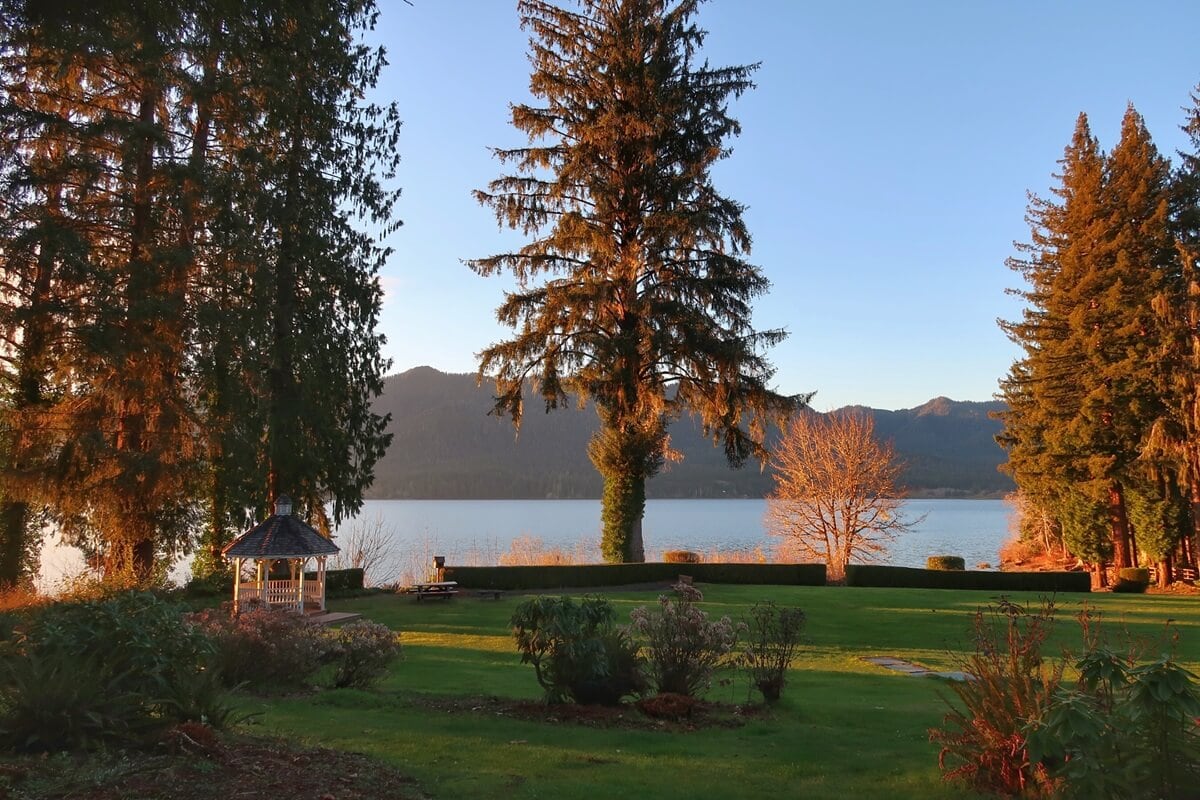
Ready to Start Planning Your Olympic National Park Winter Itinerary?
Whether you’re still gathering inspiration or already packing, I’m here to help!
👉🏽 Need help choosing your route?
Check out my 2-Day Olympic National Park Itinerary to see how I’d structure a winter trip—complete with scenic stops, overnight suggestions, and smart routing.
👉🏽 Still deciding where to stay?
Read my Olympic National Park lodging guide for recommendations, including the best places I’ve personally stayed.
👉🏽 Want personalized help?
Book a trip planning call and let’s walk through your travel dates, priorities, and logistics. Together we’ll create a custom, low-stress winter itinerary.
RELATED TRIP PLANNING POSTS:
➥ Plan Your Perfect Trip to Olympic National Park (Start Here!)
➥ 7 BEST Towns Near Olympic National Park Worth Visiting!
➥ 21 Places To Stay Near Olympic National Park (By a Local!)
➥ 10 BEST Summer Day Hikes on the Olympic Peninsula
➥ 13 BEST Beaches on the Olympic Peninsula
➥ 2 Day Olympic National Park Itinerary (Easy & Efficient!)
➥ Olympic National Park Day Trip (Best 1-Day Itineraries!)
➥ What to Pack for Olympic National Park (All Year!)
➥ Best Shoes for Olympic National Park Trails, Towns & Beaches
➥ Olympic National Park Visitor Center: 7 Reasons to Stop
SEASONAL TRAVEL POSTS:
➥ Fall in Olympic National Park (11 Best Things to Do!)
➥ Winter in Olympic National Park: 7 Things to Do + What’s Open
Skip the guesswork, stress, and hours of research—let me help you plan your itinerary!

